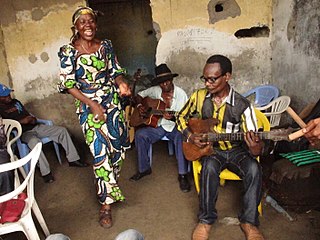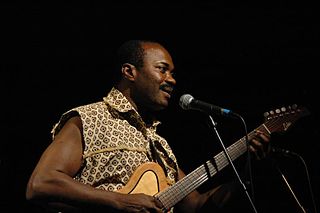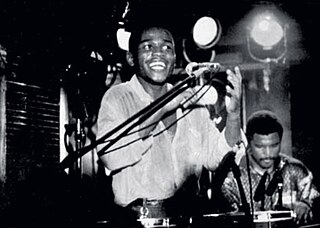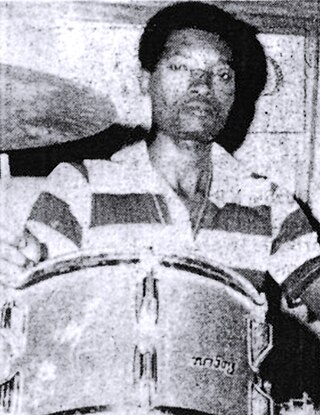
Congolese music is one of the most influential music forms of the African continent. Since the 1930s, Congolese musicians have had a huge impact on the African musical scene and elsewhere. Many contemporary genres of music, such as Kenyan Benga and Colombian Champeta, have been heavily influenced by Congolese music. In 2021, Congolese rumba joined other living traditions such as Jamaican reggae music and Cuban rumba on UNESCO's "intangible cultural heritage of humanity" list.

Soukous is a genre of dance music originating from the Democratic Republic of the Congo and the Republic of the Congo. It derived from Congolese rumba in the 1960s, with faster dance rhythms and bright, intricate guitar improvisation, and gained popularity in the 1980s in France. Although often used by journalists as a synonym for Congolese rumba, both the music and dance associated with soukous differ from more traditional rumba, especially in its higher tempo, song structures and longer dance sequences.

Jules Shungu Wembadio Pene Kikumba, known professionally as Papa Wemba, was a Congolese singer and musician who played Congolese rumba, soukous, and ndombolo. Dubbed the "King of Rumba Rock", he was one of the most popular musicians of his time in Africa and played an important role in world music. He was also a fashion icon who popularized the Sape look and style through his musical group Viva la Musica, with whom he performed on stages throughout the world.

François Luambo Luanzo Makiadi was a Congolese musician. He was a major figure in 20th-century Congolese music, and African music in general, principally as the leader for over 30 years of TPOK Jazz, the most popular and significant African band of its time. He is referred to as Franco Luambo or simply Franco. Known for his mastery of African Rumba, he was nicknamed by fans and critics "Sorcerer of the Guitar" and the "Grand Maître of Zairean Music", as well as Franco de Mi Amor by female fans. His most known hit, "Mario", sold more than 200,000 copies and was certified gold.

African popular music, like African traditional music, is vast and varied. Most contemporary genres of African popular music build on cross-pollination with Western popular music. Many genres of popular music like blues, jazz, salsa, zouk, and rumba derive to varying degrees on musical traditions from Africa, taken to the Americas by enslaved Africans. These rhythms and sounds have subsequently been adapted by newer genres like rock, and rhythm and blues. Likewise, African popular music has adopted elements, particularly the musical instruments and recording studio techniques of the Western music industry. The term does not refer to a specific style or sound but is used as a general term for African popular music.
Zaïko Langa Langa is a Congolese rumba band formed in Kinshasa, in December 1969. Established by D.V. Moanda, Henri Mongombe, Marcellin Delo and André Bita, the band evolved from the Orchestre Bel Guide National, which is seen as Zaïko's predecessor. Other co-founders included Papa Wemba, Jossart N'Yoka Longo, Félix Manuaku Waku.

Ndombolo, also known as dombolo, is a genre of dance music originating in the Democratic Republic of the Congo. Derived from soukous in the 1990s, with fast-paced hip-swaying dance rhythms, often accompanied by upbeat, percussion-driven music, the style became widespread in the mid-1990s and the subsequent decade, dominating dancefloors in central, eastern, and western Africa. It inspired West African popular music, coupé-décalé, Kuduro, and East African dance music.

Congolese rumba, also known as African rumba, is a dance music genre originating from the Republic of the Congo and Democratic Republic of the Congo. With its rhythms, melodies, and lyrics, Congolese rumba has gained global recognition and remains an integral part of African music heritage. In December 2021, it was added to the UNESCO list of intangible cultural heritage.

Jean Baptiste Emeneya Mubiala Kwamambu was a Congolese singer best known as King Kester Emeneya.

Antoine Wendo Kolosoy, known as Papa Wendo, was a Congolese musician. He is considered the "doyen" of Congolese rumba, a musical style blending traditional Kongolese rhythm and son cubano.
Cavacha is a Congolese rumba style drum beat, created by Meridjo Belobi, long-time drummer of Zaïko Langa Langa.

Pépé Felly Manuaku, also known as Pépé Fely is a Congolese rumba guitarist, songwriter, producer, arranger, bandleader and lyricist from the Democratic Republic of the Congo (DRC). He has been described as the foremost Congolese solo guitarist of his generation. He is a founding member of the iconic groups Zaïko Langa Langa, Les Ya Toupas and Grand Zaïko Wawa. His style of guitar is the last style officially credited as a "School" or Genre of guitar following the styles "Fiesta" created by "Le Docteur" Nico Kassanda and "Odemba" created by "Le Sorcier" Franco Luambo Makiadi. He is credited with establishing the guitar as the lead instrument in contemporary Congolese music introducing Synthesiser, Bouzouki, Advanced Guitar effect pedal techniques, new arrangement and recording techniques.
Jossart N'Yoka Longo is a Congolese singer, songwriter and producer. After starting his career within Bel Guide National in 1967, he became the third member, after Papa Wemba and Félix Manuaku Waku, of the legendary group Zaïko Langa Langa, of which he later established himself as the main leader.
Bob W. White is an full professor of social anthropology at the University of Montreal, Quebec, Canada. He is an expert in the Council of Europe's Intercultural Cities program and the director and founder of the Laboratory for Research on Intercultural Relations (LABRRI) at the University of Montreal. His research interests include intercultural communication, dynamics, and cities; popular culture; French-speaking Africa, particularly the Democratic Republic of the Congo; immigration policy; ethnographic fieldwork; public policy; systems theory; and pluralism. He is also coordinator of the Network of Municipalities in Immigration and Intercultural Relations of Quebec (RÉMIRI) and is part of a research network between the University of Montreal, the University of Geneva, and the Free University of Brussels.
The following is a timeline of the history of the city of Kinshasa, Democratic Republic of the Congo.
Didier Kalonji Mukeba, Known professionally by his stage name as Bill Clinton and Monseigneur or Macintosh is a Congolese singer-songwriter dancer and animator. he was a member of Wenge Musica Maison Mere orchestra by Werrason from 1997 to 2004. The name "Kalonji", as in Albert Kalonji, is a name traditionally associated with leaders of the Luba people.

Wenge Musica were a Congolese soukous band. It was formed by Didier Masela in July 1981 and directed by JB Mpiana from 1986 to the breakup of the group in 1997. The band is considered one of the most dominant on the Congolese scene.

Non Stop Dancing is the debut studio album by the Congolese rumba band Zaïko Langa Langa. Produced by Mfumu Muntu Bambi, it was released on the Zaire Music label in late 1974.

Honoré Monzuluku Mombele known professionally as NonoMonzuluku, was a Congolese composer and musician. He made significant contributions to Congolese music, particularly through his role as an animateur (atalaku) in the influential band Zaïko Langa Langa.

Jean-Marie Belobi Ng’ekerme, known professionally as Meridjo Belobi, was a Congolese drummer and songwriter. Known for being a long-time drummer for Zaïko Langa Langa, he is credited as the creator of the Cavacha drum pattern, which gained international recognition and is considered as a major contribution to African music.















